Post-Processing PEEK 3D-Printed Parts: Experimental Investigation of Annealing on Microscale and Macroscale Properties
Abstract
1. Introduction
2. Materials and Methods
2.1. Material
2.2. Three-Dimensional Printing Process
2.3. Annealing
2.4. Microscale Characterization Using AFM
2.5. X-Ray Diffraction and Fast Fourier Transformation Process
2.6. Macroscale Mechanical Testing
3. Results and Discussion
3.1. Microscale Characterization Results
3.2. Correlation with Annealing Dosages
3.3. FFT Results
3.4. Macroscale Mechanical Properties
3.5. Linking Microscale and Macroscale Properties
4. Conclusions
Author Contributions
Funding
Institutional Review Board Statement
Data Availability Statement
Conflicts of Interest
References
- Skirbutis, G.; Dzingutė, A.; Masiliūnaitė, V.; Šulcaitė, G.; Žilinskas, J. A review of PEEK polymer’s properties and its use in prosthodontics. Balt. Dent. Maxillofac. J. 2017, 19, 19–23. [Google Scholar]
- Luo, C.; Liu, Y.; Peng, B.; Chen, M.; Liu, Z.; Li, Z.; Kuang, H.; Gong, B.; Li, Z.; Sun, H. PEEK for Oral Applications: Recent Advances in Mechanical and Adhesive Properties. Polymers 2023, 15, 386. [Google Scholar] [CrossRef] [PubMed]
- Oladapo, B.I.; Zahedi, S.A. Improving bioactivity and strength of PEEK composite polymer for bone application. Mater. Chem. Phys. 2021, 266, 124485. [Google Scholar] [CrossRef]
- Haleem, A.; Javaid, M. Polyether ether ketone (PEEK) and its 3D printed implants applications in medical field: An overview. Clin. Epidemiol. Glob. Health 2019, 7, 571–577. [Google Scholar] [CrossRef]
- Verma, S.; Sharma, N.; Kango, S.; Sharma, S. Developments of PEEK (Polyetheretherketone) as a biomedical material: A focused review. Eur. Polym. J. 2021, 147, 110295. [Google Scholar] [CrossRef]
- Nguyen-Tri, P.; Ghassemi, P.; Carriere, P.; Nanda, S.; Assadi, A.A.; Nguyen, D.D. Recent applications of advanced atomic force microscopy in polymer science: A review. Polymers 2020, 12, 1142. [Google Scholar] [CrossRef]
- Karunanithi, C.; Natarajan, S. Surface characteristics of 3D printed PEEK polymer using atomic force microscopy. J. Mech. Behav. Biomed. Mater. 2024, 149, 106237. [Google Scholar] [CrossRef]
- Shinato, K.W.; Huang, F.; Jin, Y. Principle and application of atomic force microscopy (AFM) for nanoscale investigation of metal corrosion. Corros. Rev. 2020, 38, 423–432. [Google Scholar] [CrossRef]
- Shi, X.; Qing, W.; Marhaba, T.; Zhang, W. Atomic force microscopy—Scanning electrochemical microscopy (AFM-SECM) for nanoscale topographical and electrochemical characterization: Principles, applications and perspectives. Electrochim. Acta 2020, 332, 135472. [Google Scholar] [CrossRef]
- Paulo, Á.S.; García, R. Unifying theory of tapping-mode atomic-force microscopy. Phys. Rev. B Condens. Matter Mater. Phys. 2002, 66, 041406. [Google Scholar] [CrossRef]
- Schmitz, I.; Schreiner, M.; Friedbacher, G.; Grasserbauer, M. Tapping-Mode AFM in Comparison to Contact-Mode AFM as a Tool for in Situ Investigations of Surface Reactions with Reference to Glass Corrosion. Anal. Chem. 1997, 69, 1012–1018. [Google Scholar] [CrossRef]
- Martin, Y.; Williams, C.C.; Wickramasinghe, H.K. Atomic force microscope–force mapping and profiling on a sub 100-Å scale. J. Appl. Phys. 1987, 61, 4723–4729. [Google Scholar] [CrossRef]
- Garcıa, R.; Perez, R. Dynamic atomic force microscopy methods. Surf. Sci. Rep. 2002, 47, 197–301. [Google Scholar] [CrossRef]
- Labuda, A.; Kocun, M.; Meinhold, W.; Walters, D.; Proksch, R. Generalized Hertz model for bimodal nanomechanical mapping. Beilstein J. Nanotechnol. 2016, 7, 970–982. [Google Scholar] [CrossRef]
- Rajabifar, B.; Bajaj, A.; Reifenberger, R.; Proksch, R.; Raman, A. Discrimination of Adhesion and Viscoelasticity from Nanoscale Maps of Polymer Surfaces using Bimodal Atomic Force Microscopy. Nanoscale 2021, 13, 17428–17441. [Google Scholar] [CrossRef] [PubMed]
- Deng, X.; Zeng, Z.; Peng, B.; Yan, S.; Ke, W. Mechanical properties optimization of poly-ether-ether-ketone via fused deposition modeling. Materials 2018, 11, 216. [Google Scholar] [CrossRef]
- Kristiawan, R.B.; Imaduddin, F.; Ariawan, D.; Ubaidillah; Arifin, Z. A review on the fused deposition modeling (FDM) 3D printing: Filament processing, materials, and printing parameters. Open Eng. 2021, 11, 639–649. [Google Scholar] [CrossRef]
- 3D Printing High Performance Plastic Market by Type (PA, PEI, PEEK & PEKK, Reinforced HPP), Form (Filament & Pellet, Powder), Technology (FDM/FFF, SLS), Application, End-Use Industry, and Region—Global Forecasts to 2028. Available online: https://www.marketsandmarkets.com/Market-Reports/3d-printing-high-performance-plastic-market-216044197.html (accessed on 1 February 2025).
- Krapež, D.; Jusufagić, M.; Obućina, M.; Kitek Kuzman, M.; Kariž, M. Effect of Filament Material and Printing Temperature on 3D Printing Extrusion Force. Appl. Sci. 2025, 15, 2046. [Google Scholar] [CrossRef]
- Wu, W.; Geng, P.; Li, G.; Zhao, D.; Zhang, H.; Zhao, J. Influence of layer thickness and raster angle on the mechanical properties of 3D-printed PEEK and a comparative mechanical study between PEEK and ABS. Materials 2015, 8, 5834–5846. [Google Scholar] [CrossRef]
- Wang, R.; Cheng, K.J.; Advincula, R.C.; Chen, Q. On the thermal processing and mechanical properties of 3D-printed polyether ether ketone. MRS Commun. 2019, 9, 1046–1052. [Google Scholar] [CrossRef]
- Sun, X.; Cao, L.; Ma, H.; Gao, P.; Bai, Z.; Li, C. Experimental Analysis of High Temperature PEEK Materials on 3D Printing Test. In Proceedings of the 2017 9th International Conference on Measuring Technology and Mechatronics Automation (ICMTMA), Changsha, China, 14–15 January 2017. [Google Scholar] [CrossRef]
- Lannunziata, E.; Colucci, G.; Minetola, P.; Giubilini, A. Effect of annealing treatment and infill percentage on 3D-printed PEEK samples by Fused Filament Fabrication. Int. J. Adv. Manuf. Technol. 2024, 131, 5209–5222. [Google Scholar] [CrossRef]
- Vaezi, M.; Yang, S. Extrusion-based additive manufacturing of PEEK for biomedical applications. Virtual Phys. Prototyp. 2015, 10, 123–135. [Google Scholar] [CrossRef]
- Kurtaran, S. Al doped ZnO thin films obtained by spray pyrolysis technique: Influence of different annealing time. Opt. Mater. 2021, 114, 110908. [Google Scholar] [CrossRef]
- Singh, P.K.; Singh, P.K.; Sharma, K. Electrochemical synthesis and characterization of thermally reduced graphene oxide: Influence of thermal annealing on microstructural features. Mater. Today Commun. 2022, 32, 103950. [Google Scholar] [CrossRef]
- Badeghaish, W.; Wagih, A.; Rastogi, S.; Lubineau, G. Effect of high-temperature acid aging on microstructure and mechanical properties of PEEK. Polym. Test. 2024, 134, 108429. [Google Scholar] [CrossRef]
- Qian, W.; Li, W.; Nguyen, C.; Johnson, T.; Turner, J. Quantitative nanoscale measurements of the thermomechanical properties of poly-ether-ether-ketone (PEEK). J. Polym. Sci. 2020, 58, 1544–1552. [Google Scholar] [CrossRef]
- Review on Development and Dental Applications of Polyetheretherketone-Based Biomaterials and Restorations—Scientific Figure on ResearchGate. Available online: https://www.mdpi.com/1996-1944/14/2/408 (accessed on 22 January 2025).
- VICTREXTM PEEK POLYMER 450GTM General Information. 2023. Available online: www.victrex.com (accessed on 1 February 2025).
- ISO 1183-1:2019; Plastics—Methods for Determining the Density of Non-Cellular Plastics—Part 1: Immersion Method, Liquid Pycnometer Method and Titration Method. International Organization for Standardization: Geneva, Switzerland, 2019.
- ISO 11357-2:2020; Plastics—Differential Scanning Calorimetry (DSC)—Part 2: Determination of Glass Transition Temperature. International Organization for Standardization: Geneva, Switzerland, 2020.
- ISO 527-2:2012; Plastics—Determination of Tensile Properties—Part 2: Test Conditions for Moulding and Extrusion Plastics. International Organization for Standardization: Geneva, Switzerland, 2012.
- ISO 868:2003; Plastics and Ebonite—Determination of Indentation Hardness by Means of a Durometer (Shore Hardness). International Organization for Standardization: Geneva, Switzerland, 2003.
- KetaSpire® MS NT1 AM Filament Polyetheretherketone. 2019. Available online: https://www.igo3d.com/mediafiles/Sonstiges/Solvay/TDS%20-%20English%20only/KetaSpire%20MS%20NT1%20AM%20Filament%20TDS.pdf (accessed on 1 February 2025).
- ASTM D792-20; Standard Test Methods for Density and Specific Gravity (Relative Density) of Plastics by Displacement. ASTM International: West Conshohocken, PA, USA, 2020.
- ASTM D3418-15; Standard Test Method for Transition Temperatures and Enthalpies of Fusion and Crystallization of Polymers by Differential Scanning Calorimetry. ASTM International: West Conshohocken, PA, USA, 2015.
- ASTM D638-20; Standard Test Method for Tensile Properties of Plastics. ASTM International: West Conshohocken, PA, USA, 2020.
- Available online: https://www.creatbot.com/en/creatbot-peek-300.html (accessed on 1 February 2025).
- Srithep, Y.; Nealey, P.; Turng, L.-S. Effects of annealing time and temperature on the crystallinity and heat resistance behavior of injection-molded poly(lactic acid). Polym. Eng. Sci. 2013, 53, 580–588. [Google Scholar] [CrossRef]
- Regis, M.; Bellare, A.; Pascolini, T.; Bracco, P. Characterization of thermally annealed PEEK and CFR-PEEK composites: Structure-properties relationships. Polym. Degrad. Stab. 2017, 136, 121–130. [Google Scholar] [CrossRef]
- ASTM D790-23; Standard Test Methods for Flexural Properties of Unreinforced and Reinforced Plastics and Electrical Insulating Materials. ASTM International: West Conshohocken, PA, USA, 2023.
- Zeng, G.; Duan, Y.; Besenbacher, F.; Dong, M. Nanomechanics of Amyloid Materials Studied by Atomic Force Microscopy. In Atomic Force Microscopy Investigations into Biology—From Cell to Protein; InTech: Houston TX, USA, 2012. [Google Scholar] [CrossRef]
- Büchner, C.N. Single molecule studies of DNA lesion search and recognition strategies Einzel-Molekül-Studien von Strategien zur DNS-Schadenssuche und-erkennung from: Bad Kissingen. Doctoral Dissertation, Universität Würzburg, Würzburg, Germany, 2014. [Google Scholar]
- Garcia, R.; Proksch, R. Nanomechanical mapping of soft matter by bimodal force microscopy. Eur. Polym. J. 2013, 49, 1897–1906. [Google Scholar] [CrossRef]
- Coros, M.; Pogacean, F.; Turza, A.; Dan, M.; Berghian-Grosan, C.; Pana, I.O.; Pruneanu, S. Green synthesis, characterization and potential application of reduced graphene oxide. Phys. E Low-Dimens. Syst. Nanostruct. 2020, 119, 113971. [Google Scholar] [CrossRef]
- Powder X-Ray Diffraction. 29 August 2023. Available online: https://chem.libretexts.org/@go/page/314 (accessed on 1 February 2025).
- Eslami, B.; Ebeling, D.; Solares, S.D. Trade-offs in sensitivity and sampling depth in bimodal atomic force microscopy and comparison to the trimodal case. Beilstein J. Nanotechnol. 2014, 5, 1144–1151. [Google Scholar] [CrossRef]
- Chivers, R.A.; Moore, D.R. The effect of molecular weight and crystallinity on the mechanical properties of injection moulded poly(aryl-ether-ether-ketone) resin. Polymer 1994, 35, 110–116. [Google Scholar] [CrossRef]
- Morfini, L.; Guerra, M.G.; Lavecchia, F.; Spina, R.; Galantucci, L.M. Preliminary test on the effect of direct annealing on additive manufactured PEEK bending properties. Procedia CIRP 2023, 118, 705–710. [Google Scholar] [CrossRef]
- He, Y.; Shen, M.; Wang, Q.; Wang, T.; Pei, X. Effects of FDM parameters and annealing on the mechanical and tribological properties of PEEK. Compos. Struct. 2023, 313, 116901. [Google Scholar] [CrossRef]

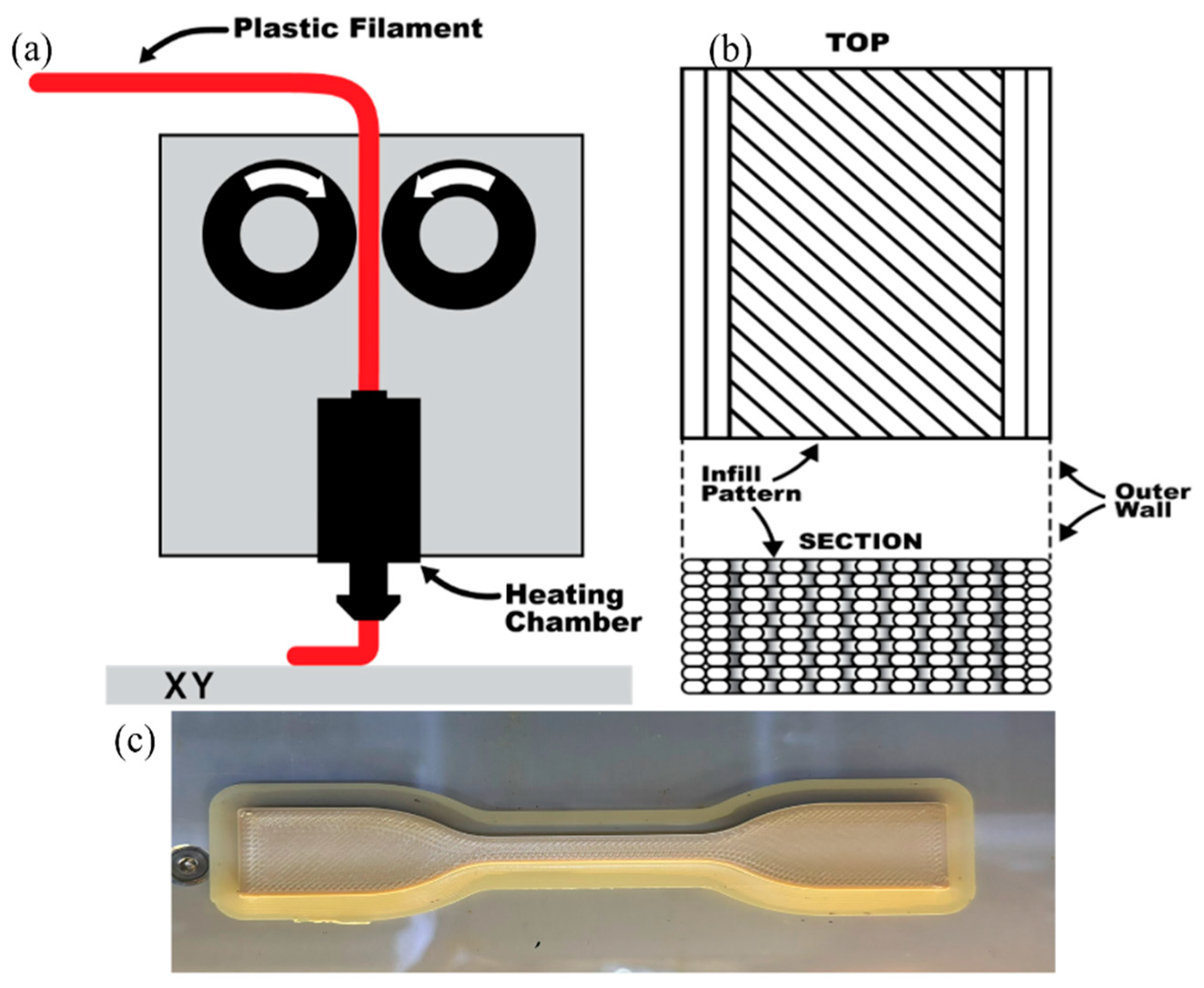
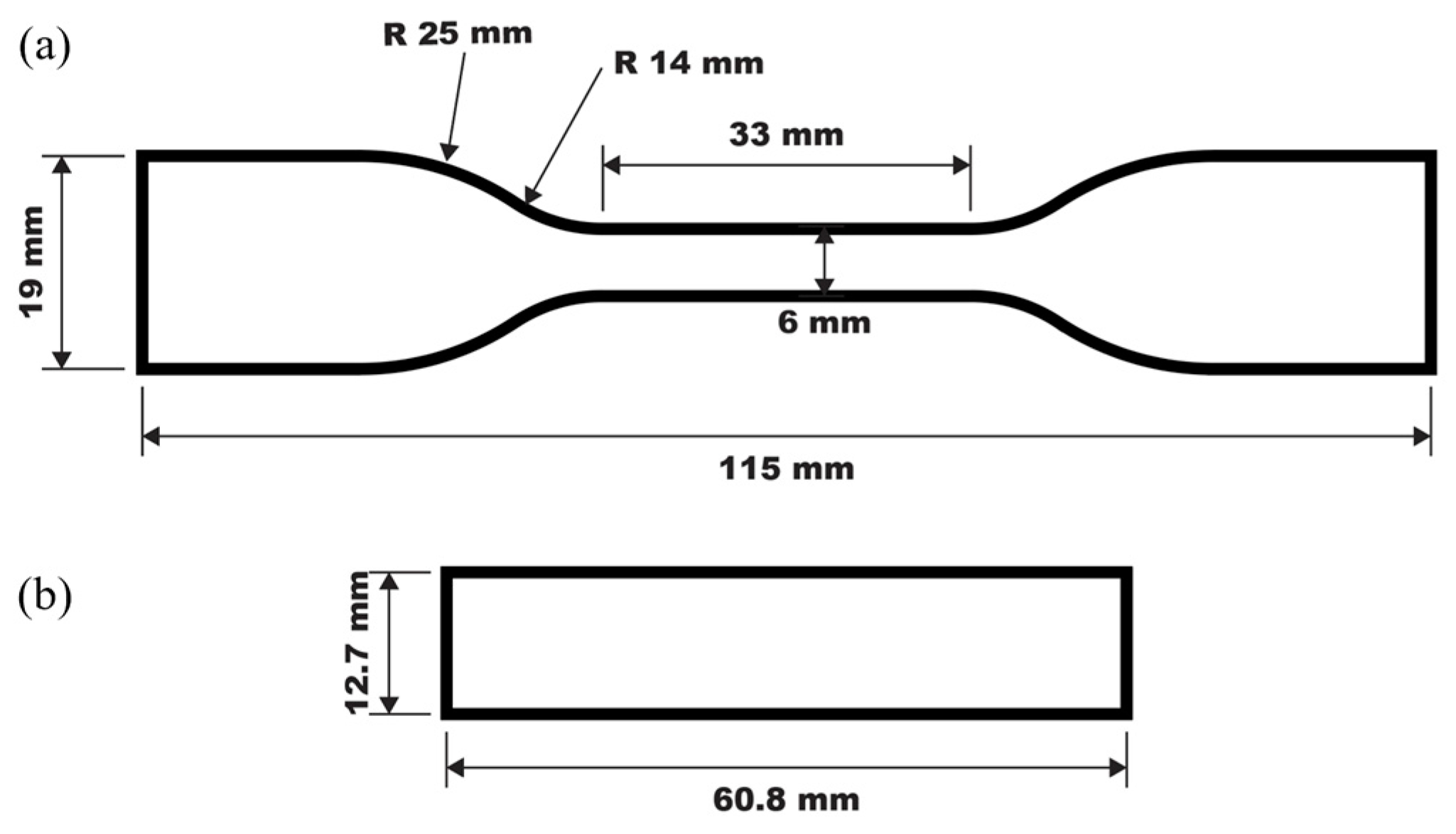

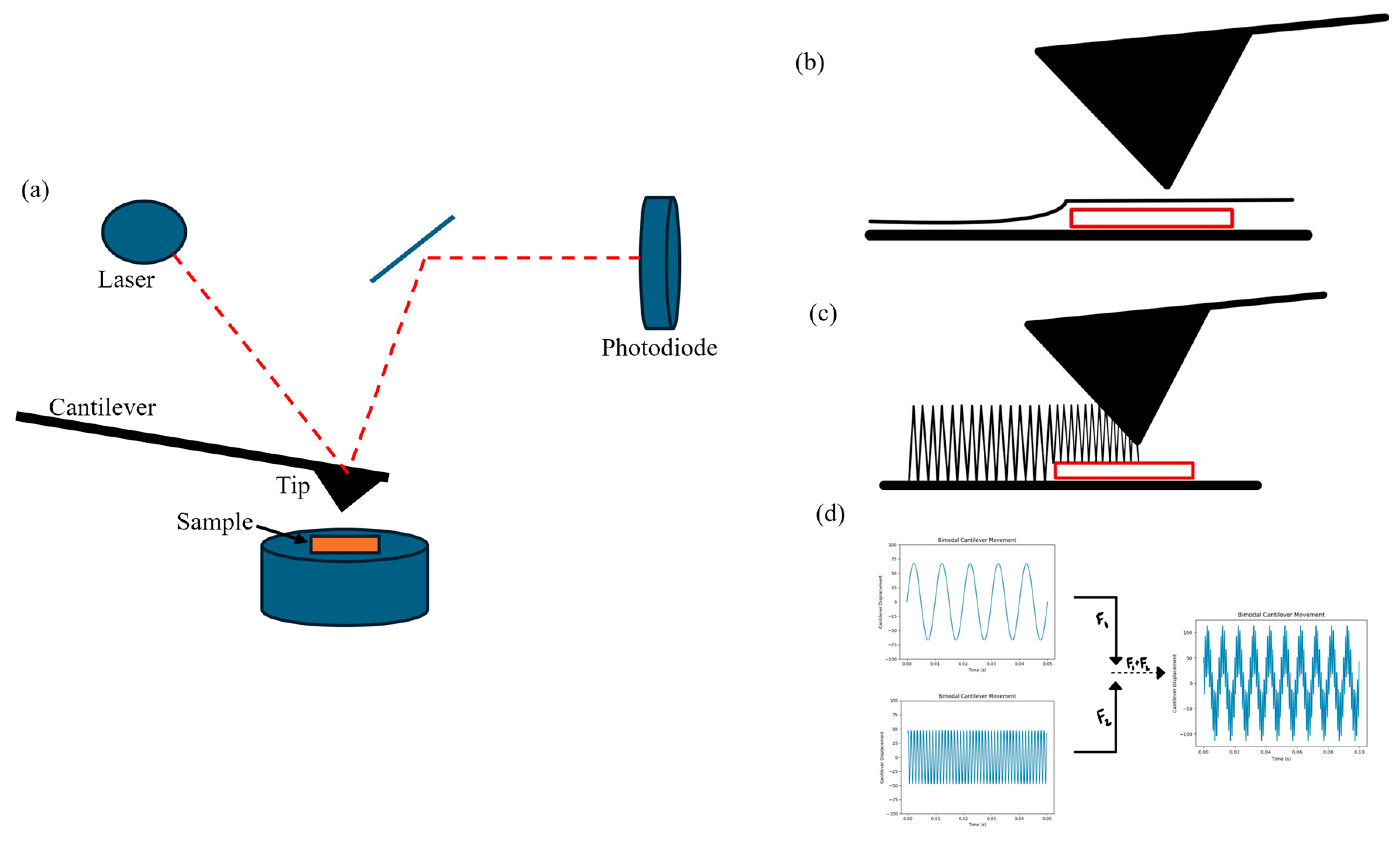
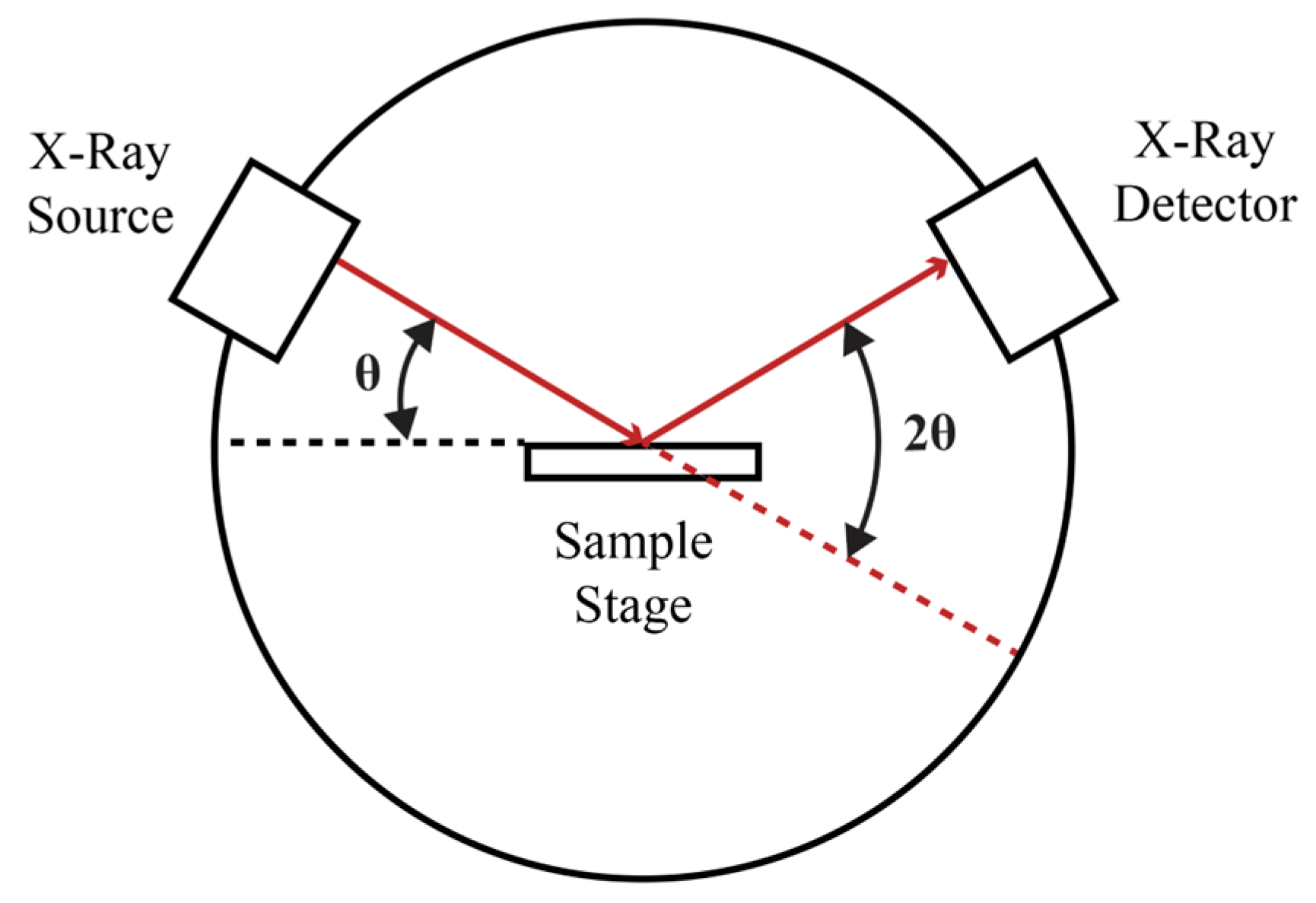




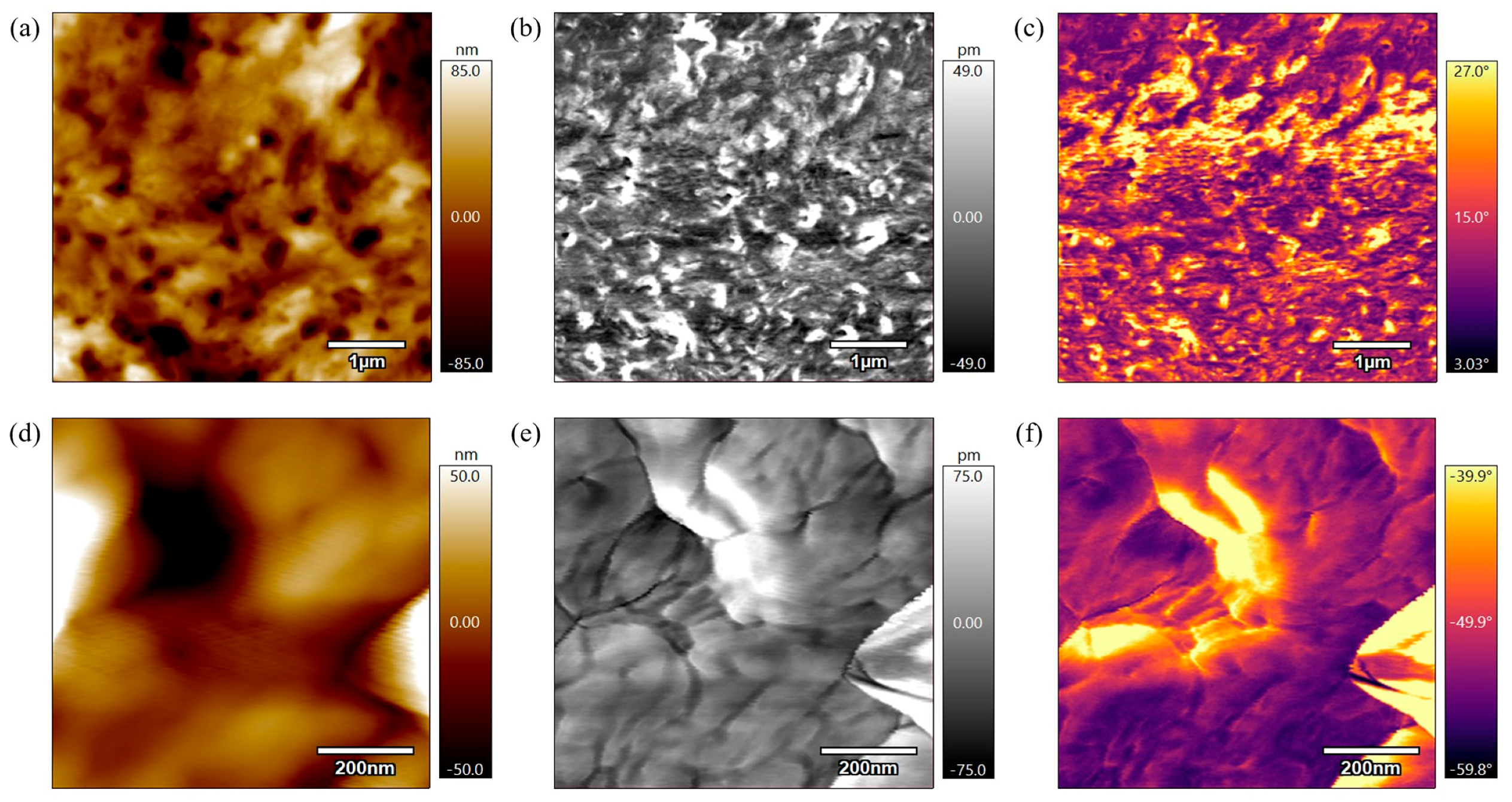




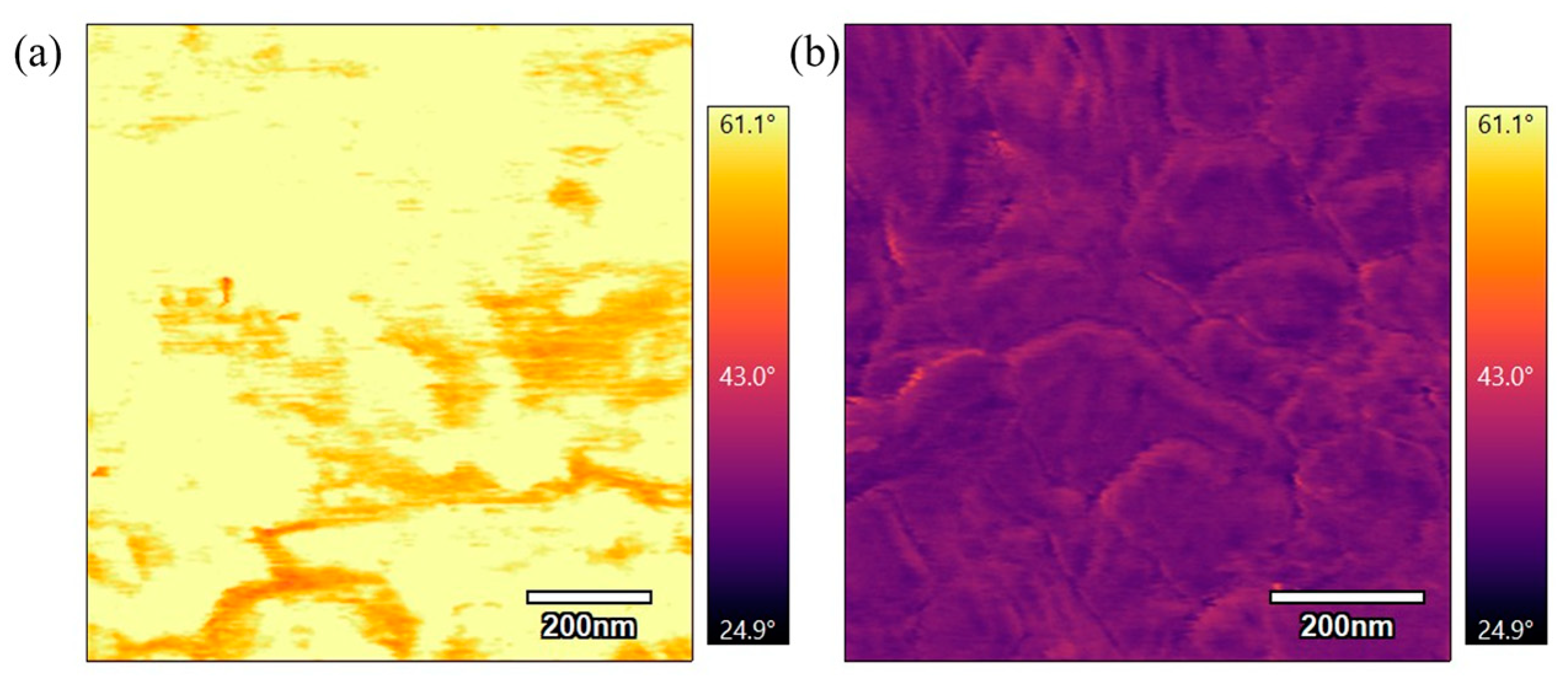
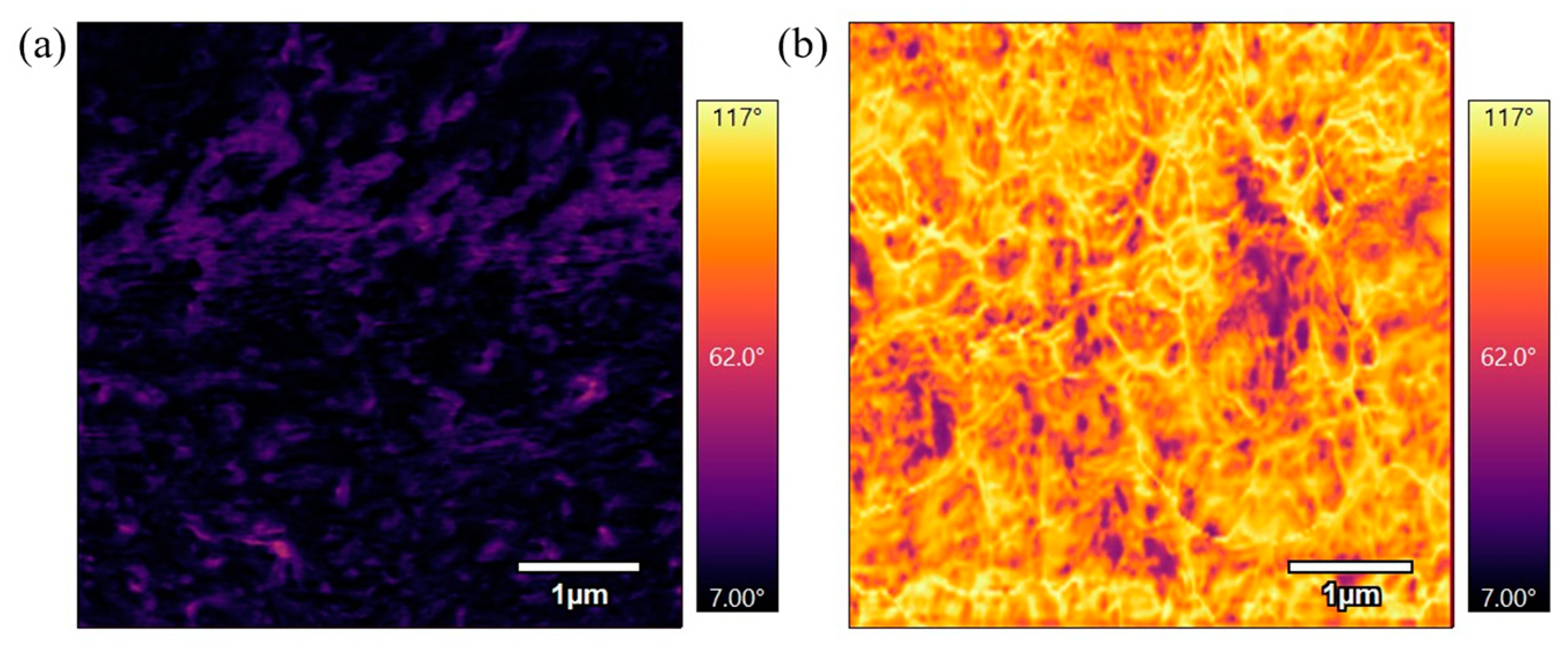


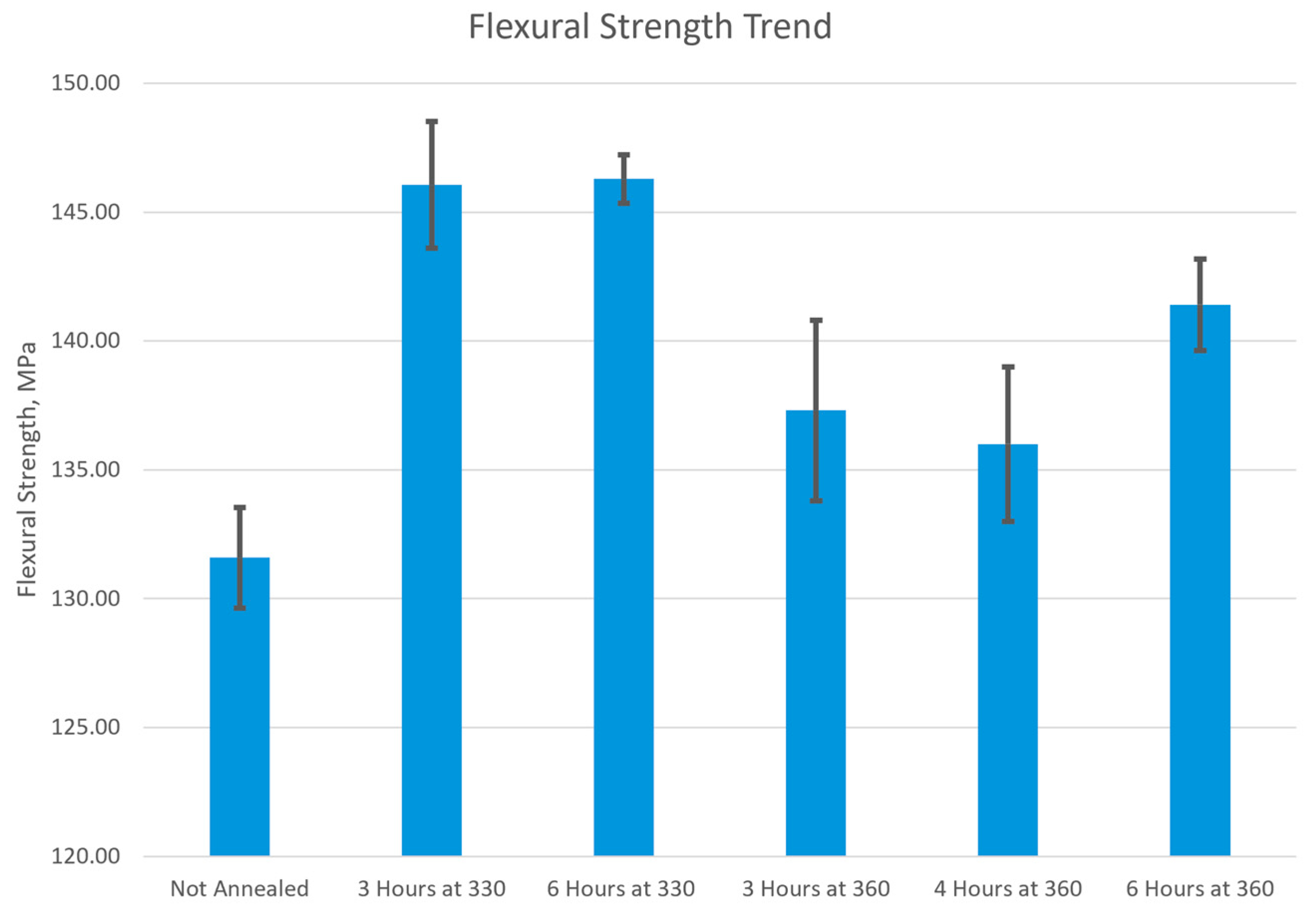

| Material Properties | Nominal Value | Unit | Test Method |
|---|---|---|---|
| Density | 1.30 | g/cm3 | ISO 1183 [31] |
| Melting Temperature | 343 | °C | ISO 11357-2 [32] |
| Tensile Stress | 98.0 | MPa | ISO 527-2 [33] |
| Shore Hardness (Shore D, 23 °C) | 84.5 | ISO 868 [34] | |
| Glass Transition Temperature Onset Midpoint | 143 150 | °C °C | ISO 11357-2 |
| Material Properties | Nominal Value | Unit | Test Method |
|---|---|---|---|
| Density | 1.29 | g/cm3 | ASTM D792 [36] |
| Melting Temperature | 343 | °C | ASTM D3418 [37] |
| Tensile Strength | 85.0 | MPa | ASTM D638 [38] |
| Filament Diameter | 1.75 | mm |
| Annealing Conditions | Sample 1 | Sample 2 | Sample 3 | Sample 4 | Sample 5 |
|---|---|---|---|---|---|
| Temperature (°C) | 330 | 330 | 360 | 360 | 360 |
| Time (hours) | 3 | 6 | 3 | 4 | 6 |
| ASTM D638 Sample | ASTM D790 [42] Sample | AFM Sample | |
|---|---|---|---|
| Unannealed |  |  |  |
| 3 h at 330 °C |  |  |  |
| 6 h at 330 °C |  |  |  |
| 3 h at 360 °C |  |  |  |
| 4 h at 360 °C |  |  |  |
| 6 h at 360 °C |  |  |  |
Disclaimer/Publisher’s Note: The statements, opinions and data contained in all publications are solely those of the individual author(s) and contributor(s) and not of MDPI and/or the editor(s). MDPI and/or the editor(s) disclaim responsibility for any injury to people or property resulting from any ideas, methods, instructions or products referred to in the content. |
© 2025 by the authors. Licensee MDPI, Basel, Switzerland. This article is an open access article distributed under the terms and conditions of the Creative Commons Attribution (CC BY) license (https://creativecommons.org/licenses/by/4.0/).
Share and Cite
Adamson, M.; Eslami, B. Post-Processing PEEK 3D-Printed Parts: Experimental Investigation of Annealing on Microscale and Macroscale Properties. Polymers 2025, 17, 744. https://doi.org/10.3390/polym17060744
Adamson M, Eslami B. Post-Processing PEEK 3D-Printed Parts: Experimental Investigation of Annealing on Microscale and Macroscale Properties. Polymers. 2025; 17(6):744. https://doi.org/10.3390/polym17060744
Chicago/Turabian StyleAdamson, Makenzie, and Babak Eslami. 2025. "Post-Processing PEEK 3D-Printed Parts: Experimental Investigation of Annealing on Microscale and Macroscale Properties" Polymers 17, no. 6: 744. https://doi.org/10.3390/polym17060744
APA StyleAdamson, M., & Eslami, B. (2025). Post-Processing PEEK 3D-Printed Parts: Experimental Investigation of Annealing on Microscale and Macroscale Properties. Polymers, 17(6), 744. https://doi.org/10.3390/polym17060744







